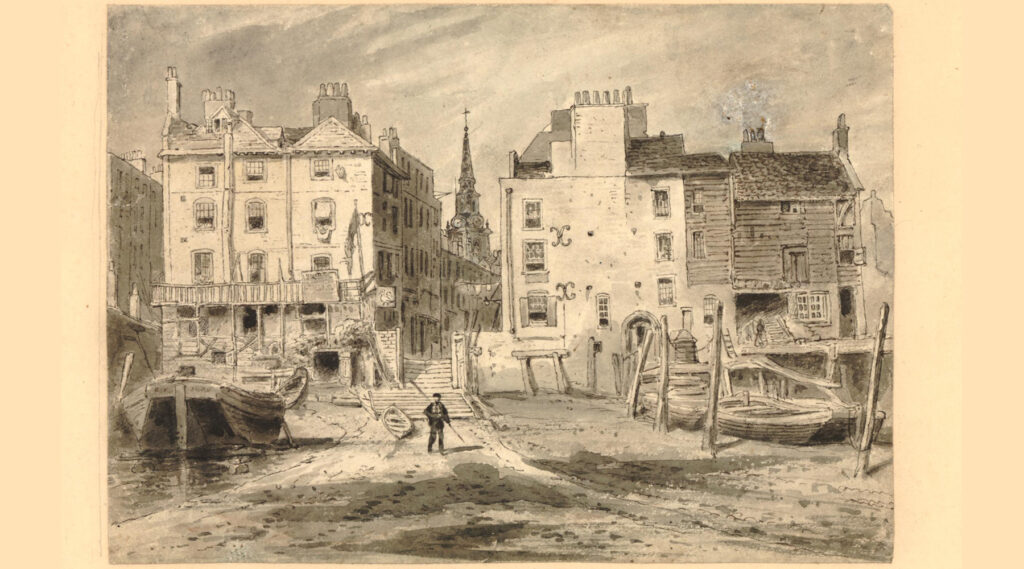This autumn will mark 200 years since Charles Dickens, as a twelve year old boy was forced to leave school and do something that he never spoke of, although it laid the foundations for much of his writings as an adult.
His impoverished family was desperate to avoid a debtor prison, so the young Charles Dickens was sent to work in a factory roughly underneath where Charing Cross station’s platforms 5 & 6 are today. From the autumn of 1823 to September 1824, for 10 hours a day six days a week, he worked alongside other children in Warren’s Blacking Factory gluing labels onto bottles of boot-cleaning blacking liquid – shoe polish.
While at the factory, Charles encountered Bob Fagin, a fellow child labourer, whose name he stored for future use.
His father was eventually sent to the debtors prison, and although released after three months, in May 1824, Charles Dickens was kept at the blacking factory until September to financially support the rest of the family. After he got out of the factory, he never spoke about it again, and it was only after his death that details emerged.
To mark the 200th anniversary of this pivotal episode, which shaped Dickens’s personality, politics and work for the rest of his life and tainted his relationship with his parents, the Charles Dickens Museum will display a collection of key items that throw more light on a punishing part of Dickens’s boyhood.
The items are now on display in Charles Dickens’s study and will be there until 21st January 2024.
Among the newly-displayed objects and documents is a pair of letters written by John Dickens – the inspiration for Wilkins Micawber in David Copperfield, which gives important insights into the father-son relationship.
One of the letters was last seen by the public back 1936, and the other has never been seen before.
Also joining the display is a remarkable survival – a stoneware bottle inscribed ‘Warren’s liquid. 30 Strand’ on one side and ‘Blacking Bottle’ on the other. It was discovered in 2006 when the Canal Museum’s ice well was being excavated.
Also on display will be an early edition of The Life of Charles Dickens, the three-volume biography by Dickens’s friend John Forster which revealed the grim truth about Dickens’s childhood. Before its publication in 1872, two years after Dickens’s death, there does not appear to have been any written account of Dickens’s child labour, nor mentions by his family and friends and it was also excluded from the account which Dickens gave to his great friend and fellow writer Wilkie Collins.
Frankie Kubicki, Senior Curator at the Charles Dickens Museum, said, “Although Dickens never spoke of the blacking factory publically, his life there was an experience he would never forget. The eleven-year-old boy who walked to work from lodgings in Camden and Southwark every morning experienced the ugliness of factory life and received a permanent mental imprint of the hardship that was lurking to find impoverished children in the capital city. In his later works, the blacking factory looms large, not only as a significant backdrop to David Copperfield, but as the driving force behind the creation of hapless child victims in his stories, such as the much-loved character, Oliver Twist. His position at the factory was to damage his relationship with his parents for the rest of his life, and his father’s continuing money problems only further deepened this void. The items which we are showing make the experience palpable and enable us to see the damaging effects of poverty on a child’s life and a close-knit family.”
The display opens at the Charles Dickens Museum today.
Ticket prices
- Adult: £12.50
- Concessions (Students, 60+ and Disabled Visitors): £10.50
- Child 6-16 years: £7.50
- Children under 6 years: Free
The museum is open Wednesday to Sunday from 10am to 5pm, with the last entry to the historic house at 4pm.
Incidentally, the plaque on the side of TGI Fridays on Chandos Street saying this is where Charles Dickens worked is in the wrong location and has the wrong dates on it.








Leave a Reply